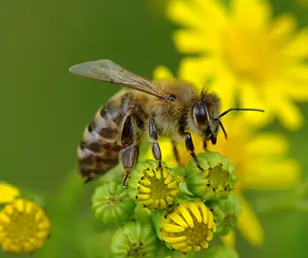It is hard to believe that they belong to the same species: The large, long-lived queen bee is busy producing offspring throughout her lifetime. The much smaller worker bees, on the other hand, gather food, take care of the beehive, look after and feed the brood – but they are infertile.
“The honey bee is an extreme example of different larval development," Professor Frank Lyko explains. Lyko, a scientist at DKFZ, studies how genes are regulated by chemical labeling with methyl groups. This type of regulation is part of what are called epigenetic regulation mechanisms – chemical alterations in the genetic material which do not change the sequence of DNA building blocks. This regulation mechanism enables the cell to adapt to changing environmental conditions.
Why is a cancer researchers interested in bees? “Cancer cells and healthy cells have identical genomes, but they behave very differently. To a large extent this is due to differences in the methylation of genes. Queen bees and worker bees also share the same genome, despite all differences in appearance. Here, too, methyl labels could be responsible for different larval development," says Lyko.
In a beehive, it is the food alone which determines the future of the offspring: If the larvae are fed pollen, they develop into worker bees. If they are to grow into queen bees, their only food is royal jelly, which is rich in fat and protein. Australian researchers have recently imitated the effects of this power food by turning off the enzyme that labels DNA with methyl groups in bee larvae. These larvae all turned into queens – completely without any royal jelly.
This was a clear indication that it is methyl labels that determine the larvae’s fate by influencing the activity of particular genes. In their current work, Lyko and his team have investigated which genes turn a bee into a queen. While previous epigenetic investigations concentrated on the methyl labeling of individual genes, the Heidelberg researchers, jointly with bee experts from Australia, have been the first to compare methylation of the whole genomes of queens and workers. “The bee with its small genome has served as a model for us to test the method. By now, we are able to perform such investigations also in the human genome," Frank Lyko explains.
Other than the richly methylated human genome, the bee genome carries considerably less methyl labels. In more than 550 genes the investigators found clear differences between worker bees and queen bees. These genes have often remained largely unchanged in the course of evolution, which is an indication for researchers that they fulfill important tasks of the cell.
Moreover, Lyko’s team identified a previously unknown mechanism by which gene methylation might influence character production. In bees, methyl labels are frequently found at so-called splice sites of genes where the blueprint for protein production is cut. If these recognition sites are made unrecognizable by chemical labels, the cell may possibly produce an altered protein with a different function. “So far, the theory has been that methyl labels block gene activity at the gene switches and thus produce diverging characteristics," Frank Lyko says. “But now we have found evidence to suggest that the mechanism discovered in bees may also play a role in cancer cells." This would mean that epigenetic factors in cancer not only turn genes on or off, but may also be responsible for production of proteins of a completely different kind.
Frank Lyko, Sylvain Foret, Robert Kucharski, Stephan Wolf, Cassandra Falckenhayn and Ryszard Maleszka: The Honey Bee Epigenomes: Differential Methylation of Brain DNA in Queens and Workers. PLoS Biology 2010, DOI: 10.1371/journal.pbio.1000506
A picture for this press release is available at:
www.dkfz.de/de/presse/pressemitteilungen/2010/images/Lyko_Biene.jpg
Picture Source: Tobias Schwerdt, Deutsches Krebsforschungszentrum
About DKFZ
With more than 3,000 employees, the German Cancer Research Center (Deutsches Krebsforschungszentrum, DKFZ) is Germany’s largest biomedical research institute. DKFZ scientists identify cancer risk factors, investigate how cancer progresses and develop new cancer prevention strategies. They are also developing new methods to diagnose tumors more precisely and treat cancer patients more successfully. The DKFZ's Cancer Information Service (KID) provides patients, interested citizens and experts with individual answers to questions relating to cancer.
To transfer promising approaches from cancer research to the clinic and thus improve the prognosis of cancer patients, the DKFZ cooperates with excellent research institutions and university hospitals throughout Germany:
- National Center for Tumor Diseases (NCT, 6 sites)
- German Cancer Consortium (DKTK, 8 sites)
- Hopp Children's Cancer Center (KiTZ) Heidelberg
- Helmholtz Institute for Translational Oncology (HI-TRON Mainz) - A Helmholtz Institute of the DKFZ
- DKFZ-Hector Cancer Institute at the University Medical Center Mannheim
- National Cancer Prevention Center (jointly with German Cancer Aid)
The DKFZ is 90 percent financed by the Federal Ministry of Research, Technology and Space and 10 percent by the state of Baden-Württemberg. The DKFZ is a member of the Helmholtz Association of German Research Centers.



